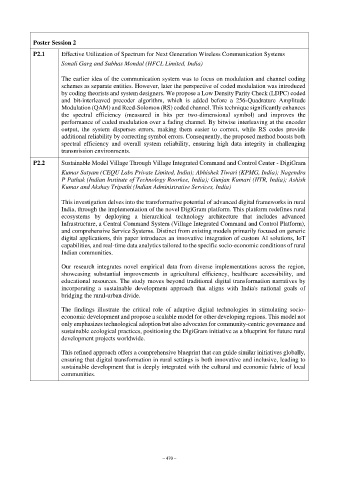Page 514 - Kaleidoscope Academic Conference Proceedings 2024
P. 514
Poster Session 2
P2.1 Effective Utilization of Spectrum for Next Generation Wireless Communication Systems
Sonali Garg and Subhas Mondal (HFCL Limited, India)
The earlier idea of the communication system was to focus on modulation and channel coding
schemes as separate entities. However, later the perspective of coded modulation was introduced
by coding theorists and system designers. We propose a Low Density Parity Check (LDPC) coded
and bit-interleaved precoder algorithm, which is added before a 256-Quadrature Amplitude
Modulation (QAM) and Reed-Solomon (RS) coded channel. This technique significantly enhances
the spectral efficiency (measured in bits per two-dimensional symbol) and improves the
performance of coded modulation over a fading channel. By bitwise interleaving at the encoder
output, the system disperses errors, making them easier to correct, while RS codes provide
additional reliability by correcting symbol errors. Consequently, the proposed method boosts both
spectral efficiency and overall system reliability, ensuring high data integrity in challenging
transmission environments.
P2.2 Sustainable Model Village Through Village Integrated Command and Control Center - DigiGram
Kumar Satyam (CEQU Labs Private Limited, India); Abhishek Tiwari (KPMG, India); Nagendra
P Pathak (Indian Institute of Technology Roorkee, India); Gunjan Kumari (IITR, India); Ashish
Kumar and Akshay Tripathi (Indian Administrative Services, India)
This investigation delves into the transformative potential of advanced digital frameworks in rural
India, through the implementation of the novel DigiGram platform. This platform redefines rural
ecosystems by deploying a hierarchical technology architecture that includes advanced
Infrastructure, a Central Command System (Village Integrated Command and Control Platform),
and comprehensive Service Systems. Distinct from existing models primarily focused on generic
digital applications, this paper introduces an innovative integration of custom AI solutions, IoT
capabilities, and real-time data analytics tailored to the specific socio-economic conditions of rural
Indian communities.
Our research integrates novel empirical data from diverse implementations across the region,
showcasing substantial improvements in agricultural efficiency, healthcare accessibility, and
educational resources. The study moves beyond traditional digital transformation narratives by
incorporating a sustainable development approach that aligns with India's national goals of
bridging the rural-urban divide.
The findings illustrate the critical role of adaptive digital technologies in stimulating socio-
economic development and propose a scalable model for other developing regions. This model not
only emphasizes technological adoption but also advocates for community-centric governance and
sustainable ecological practices, positioning the DigiGram initiative as a blueprint for future rural
development projects worldwide.
This refined approach offers a comprehensive blueprint that can guide similar initiatives globally,
ensuring that digital transformation in rural settings is both innovative and inclusive, leading to
sustainable development that is deeply integrated with the cultural and economic fabric of local
communities.
– 470 –

